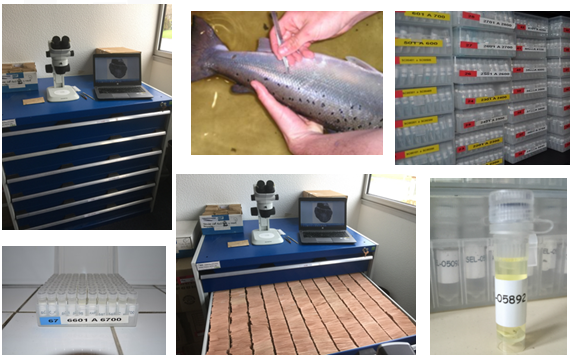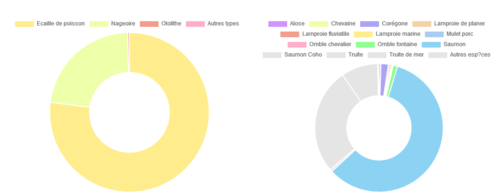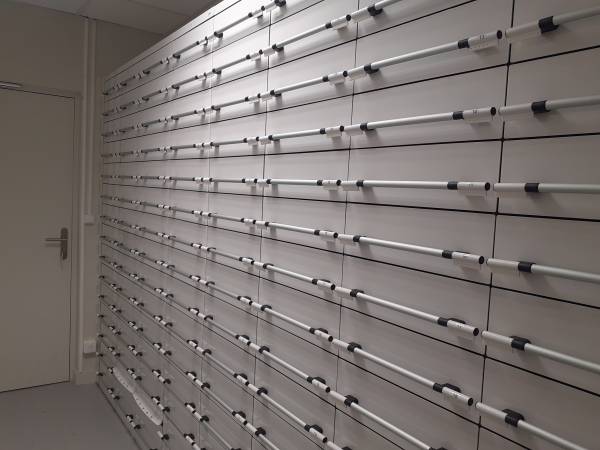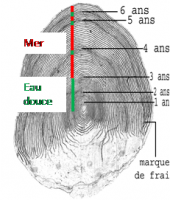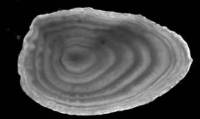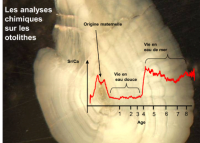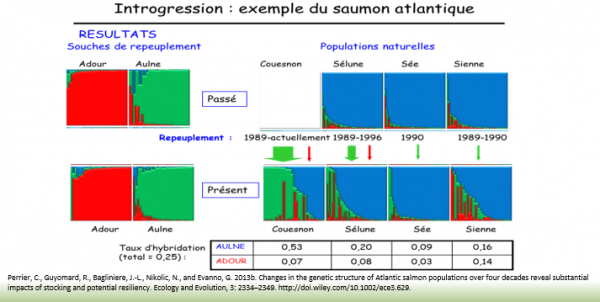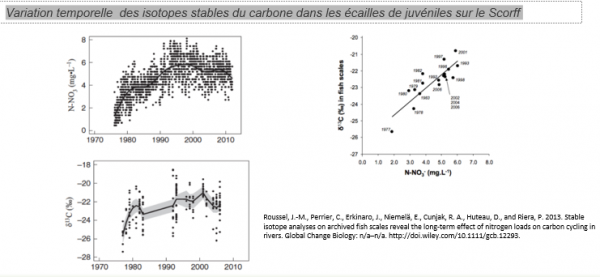This collection is characterised by its historical scope (more than 46 years), by the nature and quantity of the samples (more than 480,000 samples of around forty species of fish and lampreys), and by their geographical origin (national territory).
Origin of samples:
Long-term research and monitoring programmes carried out by the INRAE U3E and DECOD units in Rennes and the UMR ECOBIOP in Saint-Pée-sur-Nivelle as part of the ORE DiaPFC; the UMR CARRTEL in Thonon-les-Bains as part of the SOERE OLA (Observatory of Alpine Lakes), etc..
Declarations of salmonid catches (angling and professional fishing) processed by the CNICS (Centre national d'interprétation des captures de salmonidés).
Objectives:
On a scientific level, the collection contributes to the current and retrospective characterisation of fish individuals or populations, with regard to life history traits, changes in the genetic diversity of these populations and changes in the environmental conditions in which they evolve.
At a final level, this collection helps to define protection and management operations for exploited populations: definition of quotas (TACs), opening periods for fishing, etc. Similarly, the information contained and researched in the samples can be used to revisit the management of populations, some of which are protected (IUCN red list) or considered to be heritage species.
Examples of use:
Study of life traits in populations (age, reproduction, growth), the main calcified parts studied are scales and otoliths.
Scalimetry
Scales are precious tissues, and make up the bulk of the COLISA collection. The ease with which they can be preserved and stored (in an envelope in a dry environment) and the ease with which they can be sampled make them an asset for long-term research into aquatic environments and fish populations. They provide access to a wide range of information, both about the fish and the environment in which they live, using a variety of methods (structural, chemical, genetic, etc.).
The study of scales allows us to determine more or less precisely the total age of a fish, its growth, the age of migration and its periodicity, as well as the age of first reproduction. In salmonids, periods of intensive feeding are recorded on the scales by zones where the growth streaks (circuli) are widely spaced, corresponding to the summer growth period. Conversely, the winter period is marked by a narrowing, overlapping and discontinuity of the circuli. It is therefore possible to count the number of winters experienced by a fish, as well as the growth achieved between these winters (Figure 1 and 2).
This characteristic also makes it possible to detect periods spent in lakes or the sea, more productive environments where growth is much faster, in a fish's life history (Figure 2).We can therefore directly deduce the life choices of the fish, starting with the age at which they migrate.It is also possible to visualise reproduction events by spotting the spawning marks directly on the scales (Figure 2).Spawning marks are characterised by the appearance of deformed circuli as growth resumes. This deformation compensates for the loss of material caused by the erosion of the scale due to the mobilisation of various mineral elements necessary for the production of gametes. Erosion can affect a large part of the scale surface, to the point of destroying the anterior rings. A succession of spawning marks can make it impossible to determine the age of older fish (over 7-8 years old).
Scales therefore provide valuable and accurate information on the life history traits of salmonids and other fish, but their accuracy may be limited for older individuals. Furthermore, spawning marks are not formed systematically, which can lead to an underestimation of the number of spawnings.
Figure 2: Sea trout scale having spent 3 years in freshwater and 3? years at sea, with 3 overwintering periods in freshwater. The spawning mark can also be seen in the 6th year.
Otolithometry
Teleost fish have an inner ear that plays an important role in both hearing and static and dynamic balance. The well-developed inner ear of fishes is a membranous system located on either side of the midbrain, behind the eyes, and is made up of three semicircular canals terminating at their base in three pairs of sacs (Figure 1). These otic sacs contain small calcareous structures called otoliths, mainly composed of calcium carbonate in its aragonitic form (more rarely in its vateritic form) associated with a protein matrix. They play a mechanoreceptive role, participating in the perception of acceleration, pressure and vibration.
Unlike other sclerites, otoliths are present from the earliest stages of an individual's development, they grow continuously and do not undergo resorption. These characteristics enable otoliths to record a great deal of information throughout an individual's life, without ever being altered. Because otoliths are unique in that they grow radially from a central point (the primordium), cross-sectioning them produces an image similar to the growth streaks in a tree cross-section, making it possible to retrace the individual life history of fish. In addition, otoliths contain several levels of temporal information (seasonal or annual macrostructures, daily microstructures) providing information on various aspects of a fish's life.
Figure 1: Location and morphology of the auditory apparatus of a fish. Photo of a trout otolith.
Estimating age and life history traits from otoliths
Otoliths appear at the start of ontogeny: the larval fish already has otoliths when it hatches and they continue to grow throughout its life, forming successive concentric layers around its periphery. These concentric layers may undergo structural and chemical variations depending on the physiology of the fish and its environment. There are alternating dark layers of varying widths and spacing between hyaline and opaque light layers.
During periods of strong growth (warm season), the formation of aragonite crystals is accelerated by the high availability of calcium in the environment. During periods of slower growth (cold season), the concentration of aragonite crystals is lower and hyaline deposits form around the edges. A light and a dark layer are deposited each year, and counting these layers in transmitted light gives the age in years of the fish and, using mathematical models, its growth curve (Figure 2).
Figure 2: Counting of growth arrest tries on an otolith (x-axis, Age) and analysis of microchemical signals (y-axis, Strontium/Calcium ratio) to determine the age of marine migration.
Genetics
These tissues, which carry DNA, can be used to genetically characterise the individuals or populations concerned, and to revisit these characteristics retrospectively (historical samples) in the light of changes (global and local) that have occurred at the sampling sites (introgression, pedigree, effective population size, etc.).
Microchemistry - Isotopy
Using microchemistry and isotopy, analysis of these tissues can also be used to characterise the origin and environmental conditions in which these animals live: water quality, trophic chains, living environments (lakes, rivers, sea, estuaries), etc.
The main aim of using microchemical methods on otoliths is to reveal the life-history traits of fish captured in different populations of interest, traits that are impossible to obtain by any other means. In various projects, the main objective is often to study and describe marine migrations. The traits associated with this marine phase are the age of departure from the sea, the age and frequency of return to freshwater and also maternal ancestry (microchemistry is used to detect whether a fish's mother was migratory or resident).


